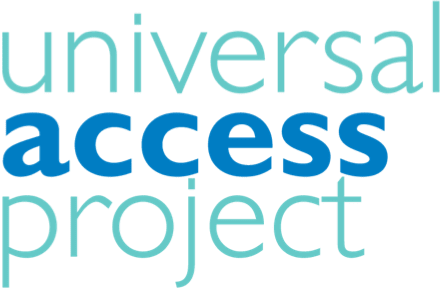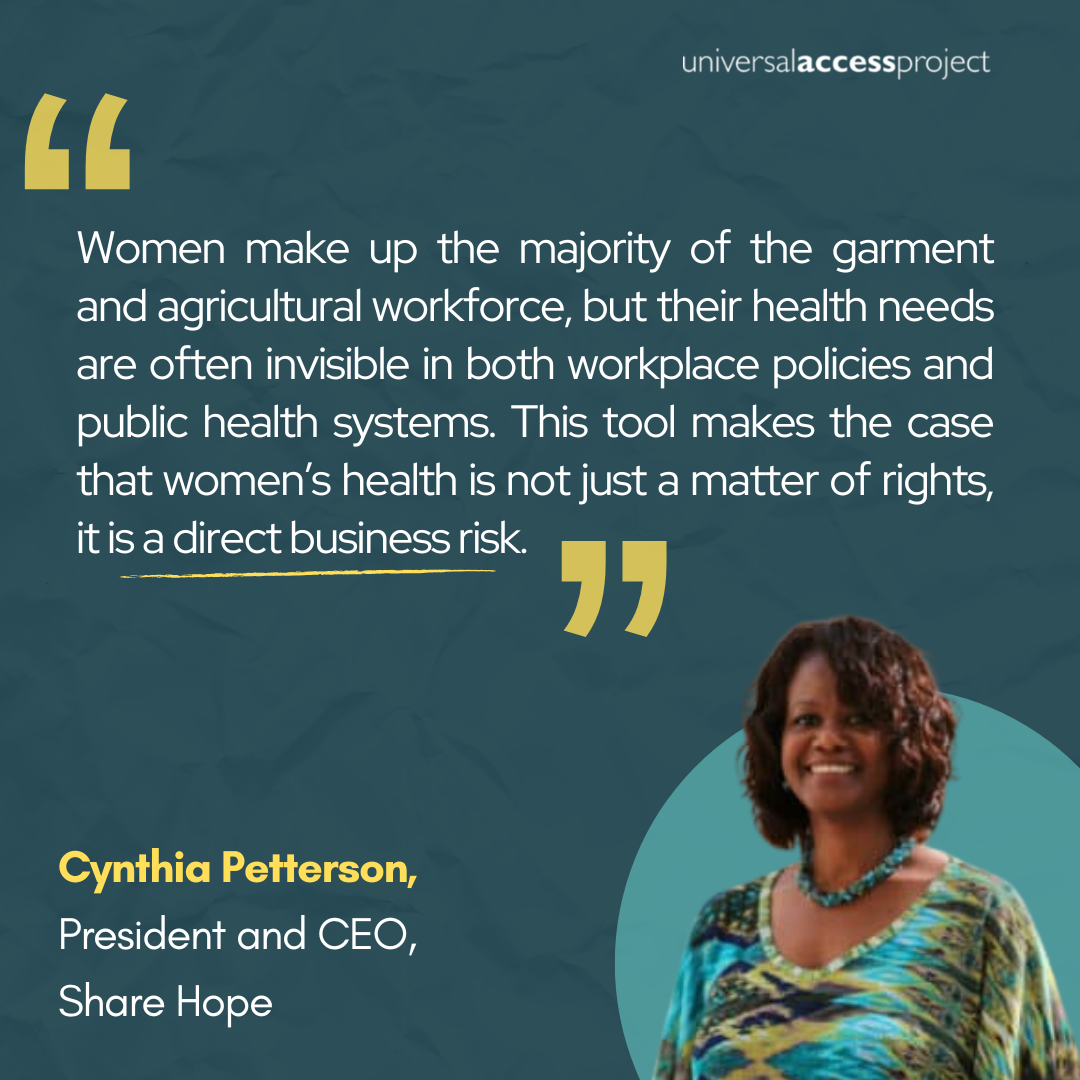Women’s Workplace Health: A Human Right, and a Business Risk
By David Wofford, Senior Director, Private Sector Strategy & Engagement, Universal Access Project in conversation with Cynthia Petterson, President and CEO of Share Hope
Assessing and mitigating risks is part and parcel of doing business in any sector, and in any region. But it’s not the norm for many businesses to consider worker health and wellbeing in their risk analysis processes. A new assessment tool from the Universal Access Project’s Accountability Platform highlights nine material risks that makes business sense for companies to take seriously.
The assessment, Worker Health Risk Assessment in Global Supply Chains: Real-Life Scenarios for Managers, outlines not only worker health as a material risk for companies but also practical responses that have been field tested. These are actionable steps that enable companies to integrate worker wellbeing, including women’s health, into their risk analysis and due diligence.
Assessing health risks can identify vulnerabilities before they become crises – and strong worker health systems are essential to stability, competitiveness, and long-term financial success. This assessment intends to offer a framework to be incorporated into existing policies, reporting, and auditing processes, going beyond compliance requirements and acknowledging the materiality of worker health to business.
I spoke with Cynthia Petterson, President and CEO of Share Hope and contributor to the report, on why, and how, companies can take action:
We see a lot of companies look at women’s workplace health from a corporate social responsibility standpoint. But this assessment presents it as an actual business risk – why?
Worker health is central to supply chain sustainability, yet it is often treated as someone else’s responsibility. I know this personally from the worker wellbeing initiatives by my company Share Hope, which was a buyer of garments produced in Haiti. The COVID-19 pandemic made it undeniable: when workers’ health collapses, so does the global supply chain. Women make up the majority of the garment and agricultural workforce, but their health needs are often invisible in both workplace policies and public health systems. This tool makes the case that women’s health is not just a matter of rights, it is a direct business risk. By naming and mapping those risks, companies can take action before a disruption occurs.
Beyond establishing women’s workplace health as a business risk, the report outlines concrete steps to mitigate the risk in IF/THEN scenarios. How does this framework help support action?
The IF/THEN structure is powerful because it moves us from the abstract to the practical. Too often, companies rely on hope that public systems or someone else will handle worker health. But hope is not a strategy. With IF/THEN, we show clearly: IF women workers face untreated health issues, THEN supply chains face absenteeism, lost productivity, and reputational damage. It’s a framework people instinctively understand. For me, it’s like how we teach our children that IF they touch a hot cup, THEN they’ll get burned. By mapping out cause and effect, we make the risks tangible and the solutions actionable.
This tool brings together the thinking of some of the best and brightest across the women’s workplace health and empowerment community. Tell us more about how it came to fruition.
This was not built in isolation. It was developed by the Accountability Platform for Women’s Health and Empowerment in Global Supply Chains, a network managed by the Universal Access Project that includes businesses, researchers and civil society organizations working together to advance needed worker health and wellbeing policies and practices at workplaces and in global supply chains. With the Platform as the convening arena, the tool was shaped by experts across sectors and continents: Health system specialists, reproductive health leaders, labor rights advocates, CSR practitioners, and supply chain researchers all contributed. Many have decades of experience working directly with garment and agricultural workers in Asia, Africa, and Latin America. That collective expertise ensured the tool is rigorous, grounded in lived realities, and relevant for businesses navigating global due diligence requirements.
Now that this tool exists – it has to be put into practice! How do you see this tool being used?
I see this as a conversation starter and a decision-making guide. We intentionally didn’t list everything that could or should be done. We wanted to point to key health risks – and to a few steps that work and can be taken based on the specific context of a company or supplier. Supply chain executives can use the framework to anticipate where health risks might undermine business continuity. Compliance teams can align it with existing due diligence processes, while sustainability leaders can use it to push for integrated worker wellbeing strategies.
There are many organizations that have practical experience implementing worker health and wellbeing in supply chains – several are on the Accountability Platform. The ILO/IFC Better Work program is a good example of a program that aligns worker health with existing due diligence processes. In fact, without their support, I don’t think Share Hope would have been able to achieve the success we did in advancing worker wellbeing. Better Work creates a bridge between international labor standards and national requirements, always applying whichever is stronger. Their model is simple but powerful: factories must comply with these standards if they want to continue exporting to major global brands. In many ways, the IF/THEN framework begins here: If you are not in compliance, then you cannot export.
It’s not about adding another layer of bureaucracy — it’s about helping companies see that investing in women’s health is not only the right thing to do but also a safeguard against business disruption. Ultimately, it’s about turning good intentions into operational reality.
How does this framework align with global standards like the UN Guiding Principles or OECD guidelines?
The UN Guiding Principles and OECD guidelines already establish that companies must identify and address risks to people in their supply chains. What the IF/THEN framework does is operationalize that expectation with a gender lens. It gives companies a practical way to integrate women’s health into their due diligence processes, which is often missing. It also supports compliance with emerging EU and national supply chain laws, where worker wellbeing is increasingly scrutinized. And, of course, the ILO sets international standards for occupational safety and health. The assessment, for the most part, does not repeat those requirements, but helps expand a health risk assessment beyond the traditional compliance approach. In short, it doesn’t replace existing standards, but augments them. And it helps companies meet them more fully and responsibly.
Why is this personally important to you?
I spent nearly 15 years working in the supply chain in Haiti. During that time, I watched women workers, without access to adequate maternal health care, suffer and sometimes die of conditions that were entirely preventable. One woman, the same age as my daughter, died of preeclampsia. Simple monitoring would have saved her life. The supply chain’s response was: “What a shame! How awful!” But ultimately it came down to: “Who will replace her?” That moment made it clear to me, women’s health cannot be an afterthought. It must be seen as central to both human dignity and business responsibility.

